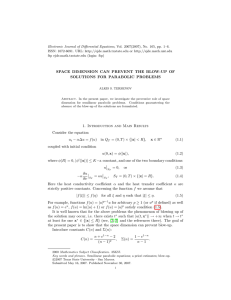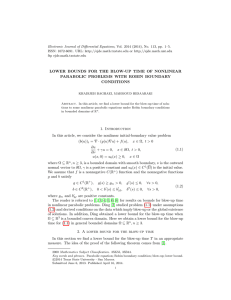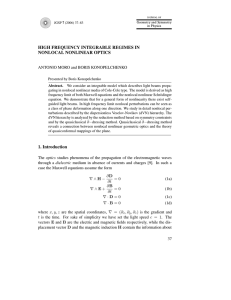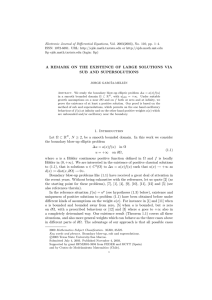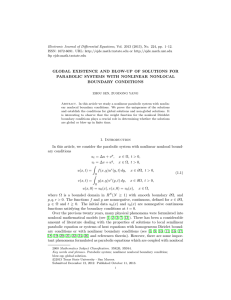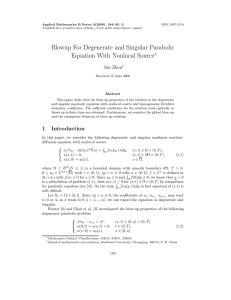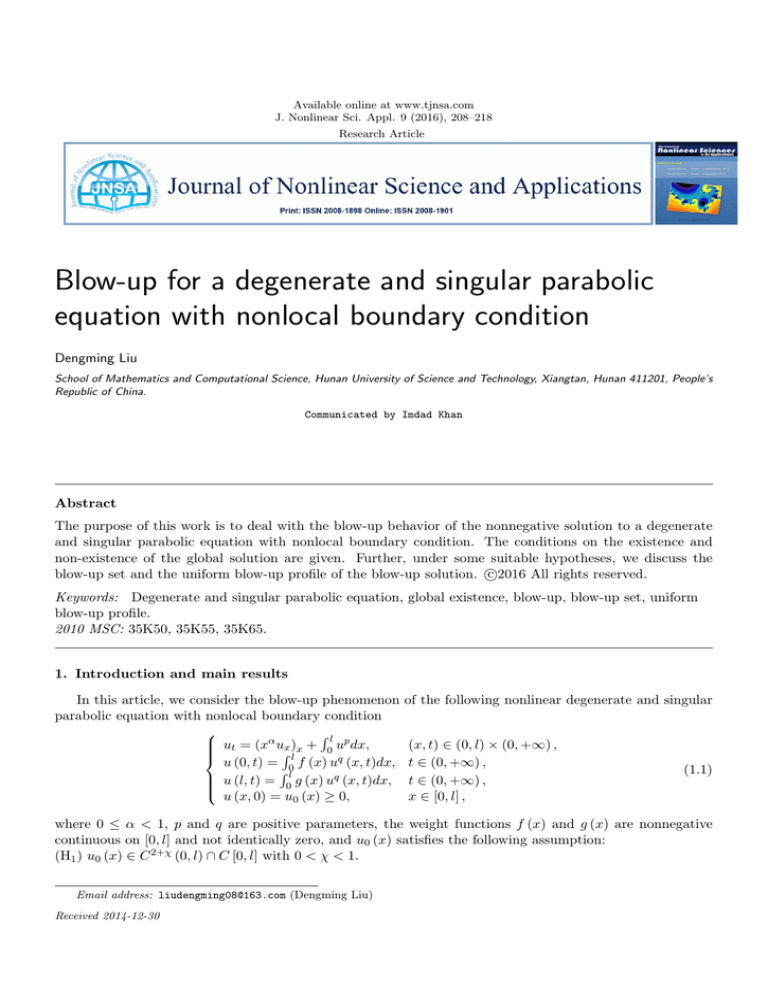
Available online at www.tjnsa.com
J. Nonlinear Sci. Appl. 9 (2016), 208–218
Research Article
Blow-up for a degenerate and singular parabolic
equation with nonlocal boundary condition
Dengming Liu
School of Mathematics and Computational Science, Hunan University of Science and Technology, Xiangtan, Hunan 411201, People’s
Republic of China.
Communicated by Imdad Khan
Abstract
The purpose of this work is to deal with the blow-up behavior of the nonnegative solution to a degenerate
and singular parabolic equation with nonlocal boundary condition. The conditions on the existence and
non-existence of the global solution are given. Further, under some suitable hypotheses, we discuss the
c
blow-up set and the uniform blow-up profile of the blow-up solution. 2016
All rights reserved.
Keywords: Degenerate and singular parabolic equation, global existence, blow-up, blow-up set, uniform
blow-up profile.
2010 MSC: 35K50, 35K55, 35K65.
1. Introduction and main results
In this article, we consider the blow-up phenomenon
parabolic equation with nonlocal boundary condition
Rl
ut = (xα ux )x + 0 up dx,
Rl
u (0, t) = 0 f (x) uq (x, t)dx,
Rl
u (l, t) = 0 g (x) uq (x, t)dx,
u (x, 0) = u0 (x) ≥ 0,
of the following nonlinear degenerate and singular
(x, t) ∈ (0, l) × (0, +∞) ,
t ∈ (0, +∞) ,
t ∈ (0, +∞) ,
x ∈ [0, l] ,
(1.1)
where 0 ≤ α < 1, p and q are positive parameters, the weight functions f (x) and g (x) are nonnegative
continuous on [0, l] and not identically zero, and u0 (x) satisfies the following assumption:
(H1 ) u0 (x) ∈ C 2+χ (0, l) ∩ C [0, l] with 0 < χ < 1.
Email address: liudengming08@163.com (Dengming Liu)
Received 2014-12-30
D. M. Liu, J. Nonlinear Sci. Appl. 9 (2016), 208–218
209
Rl
Rl
(H2 ) u0 (x) > 0 in (0, l), u0 (0) = 0 f (x) uq0 dx and u0 (l) = 0 g (x) uq0 dx.
Rl
(H3 ) (xα u0x )x + 0 up0 dx ≥ 0 for x ∈ (0, l).
The equation in (1.1) arises in large numbers of physical phenomena. For example, it can be used to
describe the conduction of heat related to the geometric shape of the body (see [2] and the references therein
for more details of the physical background). It is necessary to point out that problem (1.1) is singular and
degenerate because the coefficients of ux and uxx tend to ∞ and 0 as x → 0, respectively.
Blow-up singularity, as one of the most remarkable properties that distinguish nonlinear parabolic
problems from the linear ones, attracted extensive attention of mathematicians in the past few decades.
There are many works focused on the global existence and the blow-up property of various degenerate and singular parabolic equations (or systems) with homogenous Dirichlet boundary conditions (see
[1, 3, 4, 5, 18, 23, 24, 25] and the references therein).
On the other hand, parabolic equations with nonlocal (or nonlinear nonlocal) boundary conditions come
from applied science, for instance, in the study of the heat conduction with thermoelastcity, Day [6, 7]
derived a class of heat equation with nonlocal boundary in one-dimension space. In this model, the solution
u (x, t) describes entropy per volume of the material. Motivated by the works of Day, a lot of mathematicians
devoted to studying the blow-up behaviours of different kinds of parabolic equations with nonlocal boundary
conditions in the past few years. In particular, Lin and Liu [17] considered problem (1.1) with α = 0 and
q = 1 in multidimensional space. They obtained some results on the existence and nonexistence of the global
solutions, and derived the uniform blow-up profile estimate under some assumptions. For other works on
this topic, we refer the readers to [8, 9, 10, 19, 21] and the references therein.
However, as far as we know, there were only few articles which concerned with the blow-up behaviors
of solutions for parabolic equations coupled with nonlocal nonlinear boundary condition. Gladkov and Kim
[13, 14] considered a semilinear heat equation as the form
(x, t) ∈ Ω × (0, ∞) ,
ut = ∆u +R c (x, t) up ,
u (x, t) = Ω ϕ (x, y, t) ul (y, t) dy, (x, t) ∈ ∂Ω × (0, ∞) ,
(1.2)
u (x, 0) = u0 (x) ,
x ∈ Ω,
where p, l > 0 and Ω is a bounded open domain in RN . First, they obtained the uniqueness and the
non-uniqueness of the local solution (see [14]), then according to the different behaviors of the coefficient
functions c (x, t) and ϕ (x, y, t) as t tends to infinity, they gave some criteria for the existence of the global
solutions as well as for finite time blow-up solutions (see [13]). Recently, Gladkov and Guedda studied
problem (1.2) with c (x, t) up replaced by −c (x, t) up . The authors showed the existence, uniqueness and
non-uniqueness of local solution (see [12]). What is more, they gave the critical blow-up exponent (see [11]).
The main goal of this article is to understand the effects of α, p, q and the weight functions f (x) and g (x)
in problem (1.1) on the global existence and blow-up singularity of the solution to problem (1.1). Compared
with [13] and [17], we need more skills to handle the difficulties, which are produced by the degeneration
and singularity of problem (1.1) and the appearance of the nonlinear nonlocal boundary condition.
Throughout this article, we denote
Z l
Z l
N = max
f (x)dx,
g (x)dx ,
0
0
and let λ1 be the first eigenvalue and ζ (x) be the corresponding eigenfunction of the following eigenvalue
problem
− (xα ζx )x = λ1 ζ, 0 < x < l; ζ (0) = ζ (l) = 0.
(1.3)
In fact, from[4,
20], we
know that the principle eigenvalue λ1 of the eigenvalue problem (1.3) is the first
√
2 λ 2−α
zero of J 1−α 2−α x 2 , where J 1−α is Bessel function of the first kind of orders 1−α
2−α . In addition, we know
2−α
2−α
that ζ (x) is a positive smooth function in (0, l) and can be expressed in an explicit form as follows
√
1−α
2 λ1 2−α
2
2
ζ (x) = ax
J 1−α
x
,
2−α
2−α
(1.4)
D. M. Liu, J. Nonlinear Sci. Appl. 9 (2016), 208–218
210
where a is an arbitrary positive parameter. Here, for the sake of convenience, we normalize ζ (x) in L1 -norm
by choosing an appropriate value for parameter a.
The first part of our main results is on the existence and nonexistence of the global solution.
Theorem 1.1. Assume that p < 1 and q = 1. Then for any nonnegative initial datum u0 (x), the solution
of problem (1.1) exists globally provided that N < 1.
Theorem 1.2. Assume that min {p, q} > 1. Then for any nonnegative weight functions f (x) and g (x), the
solution of problem (1.1) exists globally provided that u0 (x) is sufficiently small.
Remark 1.3. In fact, when p > 1 and q = 1 (or q > 1 and p = 1), we can also prove that the solution of
problem (1.1) exists globally for sufficiently small initial data. In the case p > 1 and q < 1 (or q > 1 and
p < 1), we guess that the solution of problem (1.1) exists globally for small initial data, but we can not
give a proof for this conjecture by the methods used in this paper. We hope to address this question in the
future.
Theorem 1.4. Assume that max {p, q} > 1.
(i) If p = max {p, q}, then for any nonnegative weight functions f (x) and g (x), the solution of problem
(1.1) blows up in finite time provided that u0 (x) satisfies
1
Z l
p−1
u0 (x) ζ (x) dx > λ1 max ζ (x)
.
x∈[0,l]
0
(ii) If q = max {p, q}, then for any f (x) ≥ 0 and g (x) > 0, the solution of problem (1.1) blows up in finite
time provided that u0 (x) satisfies
1
max ζ (x) q−1
Z l
x∈[0,l]
u0 (x) ζ (x) dx >
.
min g (x)
0
x∈[0,l]
The second part of our main results is on the blow-up set and the uniform blow-up profile of the blow-up
solution. Inh this part, we need ithe following
two additional iassumptions on initial datum u0 (x).
h
Rl
Rl p
α
α
(H4 ) lim (x u0x )x + 0 u0 dx = lim (x u0x )x + 0 up0 dx = 0.
x→0+
(H5 ) (xα u0x )x ≤ 0 in (0, l).
x→l−
Theorem 1.5. Suppose that hypotheses (H1 ) − (H5 ) hold, and assume that p > 1, q = 1 and N ≤ 1. Then
the blow-up set of the blow-up solution u (x, t) of problem (1.1) is the whole interval (0, l).
Theorem 1.6. Under the assumptions of Theorem 1.5, we have
1
− p−1
u (x, t) ∼ [l (p − 1) (T − t)]
a.e. in (0, l) as t → T,
where T is the blow-up time.
Remark 1.7. There are many functions which satisfy the condition
Z l
Z l
N = max
f (x)dx,
g (x)dx ≤ 1
0
0
in Theorems 1.1, 1.5 and 1.6. For example,
1
π
cos x.
l
2l
The rest of this paper is organized as follows. In Section 2, we state the comparison theorem, the
existence and uniqueness result on the local solution of problem (1.1) as preliminaries. Section 3 is mainly
about the existence and nonexistence of the global solution and the proofs of Theorems 1.1, 1.2 and 1.4.
The blow-up set and the uniform blow-up profile of the blow-up solution are considered in section 4.
f (x) = g (x) =
D. M. Liu, J. Nonlinear Sci. Appl. 9 (2016), 208–218
211
2. Preliminaries
In this section, we will establish a suitable comparison principle for problem (1.1) and state the existence
and uniqueness result on the local solution. For the sake of simplify, we first denote IT = (0, l) × (0, T ) and
I T = [0, l] × [0, T ). We begin with the definitions of the super-solution and sub-solution to problem (1.1).
Definition 2.1. A nonnegative
function u (x, t) is called a super-solution of problem (1.1) if
2,1
u (x, t) ∈ C (IT ) ∩ C I T satisfies
R
α u ) + l up dx,
u
≥
(x
(x, t) ∈ IT ,
t
x
x
0
Rl
u (0, t) ≥ 0 f (x) uq (x, t)dx, t ∈ (0, T ) ,
(2.1)
Rl
u (l, t) ≥ 0 g (x) uq (x, t)dx, t ∈ (0, T ) ,
u (x, 0) ≥ u0 (x) ,
x ∈ [0, l] .
Similarly, u (x, t) ∈ C 2,1 (IT ) ∩ C I T is called a sub-solution of problem (1.1) if it satisfies all the reversed
inequalities in (2.1). We say that u (x, t) is a solution of problem (1.1) if it is both a sub-solution and a
super-solution of problem (1.1).
Now, by making use of the similar arguments as those in [8], we can prove the following maximum
principle, which plays a critical role in the discussions of the blow-up set and the uniform blow-up profile of
the blow-up solution.
Lemma 2.2. Let ω (x, t) ∈ C 2,1 (IT ) ∩ C I T satisfy
Rl
α
ωt − (x ωRx )x ≥ 0 θ1 (x, t) ω (x, t) dx, (x, t) ∈ IT ,
l
(2.2)
t ∈ (0, T ) ,
ω (0, t) ≥ 0 θ2 (x) ω (x, t)dx,
R
l
t ∈ (0, T ) ,
ω (l, t) ≥ 0 θ3 (x) ω (x, t)dx,
where θi (x, t), i = 1, 2, 3, are bounded functions, θ1 (x, t) is nonnegative for (x, t) ∈ IT , θ2 (x) and θ3 (x)
are nonnegative, nontrivial in (0, l). Then ω (x, 0) > 0 in [0, l] implies that ω (x, t) > 0 for (x, t) ∈ IT .
Moreover, if one of the following
conditions holds,
o (a) θ2 (x) = θ3 (x) ≡ 0 for x ∈ (0, l); (b) θ2 (x), θ3 (x) ≥ 0
nR
Rl
l
for x ∈ (0, l) and max 0 θ2 (x) dx, 0 θ3 (x) dx ≤ 1, then ω (x, 0) ≥ 0 in [0, l] leads to ω (x, t) ≥ 0 for
(x, t) ∈ IT .
By using the idea in [16], we can show the following comparison principle, which plays an important
part in investigating the existence of the global solution for problem (1.1).
Proposition 2.3 (Comparison principle). Let u (x, t) and u (x, t) be a nonnegative super-solution and subsolution of problem (1.1), respectively. Suppose that either u (x, t) > 0 or u (x, t) > 0 if min {p, q} < 1. Then
u (x, t) ≥ u (x, t) holds in I T if u (x, 0) ≥ u (x, 0) for x ∈ [0, l].
Next, we state the result on the existence and uniqueness of the local solution of problem (1.1) at the
end of this section.
Theorem 2.4 (Local existence and uniqueness). Assume that (H1 ), (H2 ) and (H3 ) hold, then there exists
a small positive real number T such that problem (1.1) admits a nonnegative solution u(x, t) ∈ C I T ∩
C 2,1 (IT ). Furthermore, assume that the initial datum u0 (x) is positive for the case min {p, q} < 1, then the
local solution of problem (1.1) is unique.
Remark 2.5. We can get the proof of Theorem 2.4 by using regularization method and Schauder’s fixed
point theorem. For more details, we refer the readers to [4, 22]. Moreover, for the case min {p, q} ≥ 1, the
uniqueness of the local solution holds without the restrictive condition u0 > 0.
D. M. Liu, J. Nonlinear Sci. Appl. 9 (2016), 208–218
212
3. Global existence and blow-up in finite time
In this section, first of all, by constructing some appropriate global super-solutions and employing comparison principle, we investigate the existence of the global solutions for problem (1.1), and give the proofs
of Theorems 1.1 and 1.2, respectively.
Proof of Theorem 1.1. Putting
σ (x) =
l0 1−α
0 2−α
x
−
x
+ N,
2−α
2−α
where
(1 − N ) (2 − α)3−α
0,
l2−α (1 − α)1−α
0 ∈
x ∈ [0, l] ,
!
is a given constant. Then, it is not difficult to verify that
− (xα σx )x = 0 , 0 < x < l,
σ (0) = σ (l) = N ,
and
min σ (x) = N ,
x∈[0,l]
max σ (x) = N +
x∈[0,l]
0 l2−α (1 − α)1−α
< 1.
(2 − α)3−α
(3.1)
(3.2)
(3.3)
Defining
v1 (x, t) = 1 σ (x) ,
where
(
1 = max N −1
p 1 )
1−p
max (u0 (x) + 1) , l0 max σ (x)
.
x∈[0,1]
(3.4)
x∈[0,l]
Calculating directly, one has
Z l
L (v1 ) :≡ v1t − (xα v1x )x −
v1p dx
0
Z l
σ p dx
= 0 1 − p1
0
p
≥ 0 1 − l 1 max σ (x) .
x∈[0,l]
By p < 1 and the choice of the value for 1 , for any x ∈ (0, l) and t ∈ (0, ∞), we can easily deduce that
L (v1 ) ≥ 0.
(3.5)
On the other hand, for x = 0, we have that
Z
l
Z
v1 (0, t) = 1 σ (0) ≥
1 f (x) dx ≥
0
Z l
=
f (x) v1 (x, t) dx.
l
1 f (x) σ (x) dx
0
(3.6)
0
By the similar argument, for x = l, we can claim that
Z l
v1 (l, t) ≥
g (x) v1 (x, t) dx.
(3.7)
0
From (3.4), (3.5), (3.6) and (3.7), we can infer that v1 (x, t) is a global super-solution of problem (1.1). And
hence, by comparison principle, we know that the solution u (x, t) of problem (1.1) exists globally. The proof
of Theorem 1.1 is complete.
D. M. Liu, J. Nonlinear Sci. Appl. 9 (2016), 208–218
213
e1 be
Proof of Theorem 1.2. Taking a bounded open interval (a, b) ⊂ R such that (0, l) ⊂⊂ (a, b). Letting λ
e
the first eigenvalue and ζ (x) be the associated eigenfunction of the following eigenvalue problem
e1 ζ,
e a < x < b; ζ (a) = ζ (b) = 0.
(3.8)
− xα ζex = λ
x
It is clear that there exists a constant µ1 ∈ (1, ∞) such that
max ζe (x) < µ1 min ζe (x) .
x∈[a,b]
(3.9)
x∈[0,l]
Putting
µ1 µ2 e
ζ (x) ,
max ζe (x)
ζb (x) =
x∈[a,b]
where µ2 will be specialized later. Then it is easy to verify that
max ζb (x) = µ1 µ2
x∈[a,b]
and
max ζe (x)
max ζb (x)
x∈[a,b]
=
min ζb (x)
x∈[0,l]
x∈[a,b]
< µ1 .
min ζe (x)
(3.10)
x∈[0,l]
Furthermore, ζb (x) also satisfies problem (3.8). From (3.9), we have that
min ζb (x) > µ2 .
(3.11)
x∈[0,l]
Setting
"
e1 t
−λ
h (t) = e
1+
#−
lµp1 µp−1
2
1
p−1
,
e1 e(p−1)λe1 t
λ
(3.12)
and
v2 (x, t) = ζb (x) h (t) .
A Simple computation shows that
Z l
e1 ζb (x) h (t) − hp (t)
L (v2 ) = ζb (x) h0 (t) + λ
ζbp (x) dx
0
h
i
p p−1 p
0
b
e
≥ ζ (x) h (t) + λ1 h (t) − lµ1 µ2 h (t)
(3.13)
≥ 0.
Choosing µ2 ∈ 0, (N µq1 )
1
− q−1
, and noticing that h (t) ∈ (0, 1), then we have that
v2 (0, t) ≥ µ2 h (t) ≥
N µq1 µq2 hq
and
Z
v2 (l, t) ≥
0
l
Z
(t) ≥
0
l
f (x) v2q (x, t) dx,
g (x) v2q (x, t) dx.
(3.14)
(3.15)
By exploiting (3.13), (3.14) and (3.15), we can conclude that v2 (x, t) is a global super-solution of problem
(1.1) provided that
!− 1
p−1
e1 + lµp µp−1
λ
1 2
.
(3.16)
u0 (x) ≤ µ2
e1
λ
That is to say, the solution u (x, t) of problem (1.1) exists globally if u0 (x) fulfill (3.16). The proof Theorem
1.4 is complete.
D. M. Liu, J. Nonlinear Sci. Appl. 9 (2016), 208–218
214
Now, by using a slight variant of the eigenfunction method (Kaplan’s Method), which is introduced by
Kaplan in [15], we will discuss the blow-up singularity in finite time for problem (1.1) with max {p, q} > 1
and sufficiently large initial data.
Proof of Theorem 1.4. Letting an auxiliary function Π (t) be defined as
Z l
Π (t) =
u (x, t) ζ (x) dx.
0
Multiplying both sides of the equation in problem (1.1) by ζ (x), where ζ (x) is given by (1.4), and integrating
from 0 to l, one has
Z l
Z l
p
0
α
u dx ζ (x) dx
Π (t) =
(x ux )x +
0
0
(3.17)
Z l
Z l
g (x) uq dx.
up dx + λ1
= −λ1 Π +
0
0
When p = max {p, q} > 1, then it follows from (3.17) and Jensen’s inequality that
1
Πp .
max ζ (x)
Π0 (t) ≥ −λ1 Π +
(3.18)
x∈[0,l]
Solving (3.18), we obtain
Π (t) ≥
1
p−1
λ1 max ζ (x)
x∈[0,l]
1−p
1 − 1 − λ1 Π (0)
max ζ (x) eλ1 (p−1)t
.
(3.19)
x∈[0,l]
From (3.19), we know that if
Z
Π (0) =
l
1
p−1
u0 (x) ζ (x) dx > λ1 max ζ (x)
,
x∈[0,l]
0
then
lim Π (t) = ∞,
t→T
where
T =
1
Π (0)p−1
ln
.
λ1 (p − 1) Π (0)p−1 − λ1 max ζ (x)
x∈[0,l]
When q = max {p, q} > 1, we can deduce from (3.17) that
min g (x)
x∈[0,l]
Π0 (t) ≥ −λ1 Π +
Πq ,
max ζ (x)
x∈[0,l]
which implies that, for any positive weight function g (x), Π (t) tends to infinity in a finite time provided
that
1
max ζ (x) q−1
x∈[0,l]
Π (0) >
.
min g (x)
x∈[0,l]
The proof of Theorem 1.4 is complete.
D. M. Liu, J. Nonlinear Sci. Appl. 9 (2016), 208–218
215
4. Blow-up set and uniform blow-up profile
In this section, we will discuss the blow-up set and the uniform blow-up profile of the blow-up solution
for problem (1.1). Throughout this section, we assume that p > 1, q = 1 and N ≤ 1. From Theorem 1.4,
we see that the solution u (x, t) of problem (1.1) blows up in finite time for sufficiently large initial data. In
addition, we denote T the blow-up time.
From (H1 ) − (H5 ), we know that there exist a sufficiently small positive constant ε1 and a nonnegative
function w0ε (x) such that
(1) w0ε ∈ C 2+χ (ε, l − ε) ∩ C [ε, l − ε] with χ ∈ (0, 1) and ε ∈ (0, ε1 ].
R l−ε
R l−ε
(2) w0ε (ε) = ε f (x) w0ε (x) dx and w0ε (l − ε) = ε g (x) w0ε (x) dx.
(3) w0ε (x) < u0 (x) for x ∈ (ε, 2ε) ∪ (l − 2ε, l − ε), and w0ε (x) = u0 (x) for x ∈ [2ε, l − 2ε].
(4) (xα w0εx )x ≤ 0 for x ∈ (ε, l − ε).
(5) w0ε is non-increasing with respect to ε in (0, ε1 ]. Moreover
lim
x→ε+
Z
α
(x w0εx )x +
ε
l−ε
p
w0ε
dx
=
lim
x→(l−ε)−
Z
(xα w0εx )x +
ε
l−ε
p
w0ε
dx
= 0.
Rl p
(6) (xα w0εx )x + 0 w0ε
dx ≥ 0 for ε ∈ (0, ε1 ] and x ∈ (ε, l − ε).
It is obvious that
lim w0ε (x) = u0 (x) .
ε→0+
Now, we consider the following regularized problem
R
α w ) + l−ε w p dx,
w
=
(x
ε
εt
εx
x
ε
R l−ε
wε (ε, t) = ε f (x) wε (x, t)dx,
R l−ε
wε (l − ε, t) = ε g (x) wε (x, t)dx,
wε (x, 0) = w0ε (x) ,
(x, t) ∈ (ε, l − ε) × (0, +∞) ,
t ∈ (0, +∞) ,
t ∈ (0, +∞) ,
x ∈ [0, l] .
(4.1)
Then it is not difficult to show that there exists a unique solution wε (x, t) for problem (4.1). In addition,
from the arguments of Section 2 in [24], it follows that
lim wε (x, t) = u (x, t) ,
ε→0+
where u (x, t) is the solution of problem (1.1).
Lemma 4.1. Suppose that hypotheses (H1 ) − (H5 ) hold, and assume that p > 1, q = 1 and N ≤ 1. Then
(xα ux )x ≤ 0 holds for (x, t) ∈ IT .
Proof. Taking η = (xα wεx )x , then from (4.1), we have
Z l α
α
ηt = x (x wεx )x +
wεp
= (xα ηx )x
0
x
(4.2)
x
holds for any (x, t) ∈ (ε, l − ε) × (0, T ). On the other hand, for any t ∈ (0, T ), we have
Z
l−ε
Z
l−ε
f (x) wεt (x, t) dx −
wεp (x, t) dx
ε
ε
Z l−ε
Z l−ε
Z l−ε
=
f (x) (xα wεx )x +
wεp (x, t) dx dx −
wεp (x, t) dx
ε
ε
ε
Z l−ε
Z l−ε
Z l−ε
=
f (x) η (x, t) dx +
f (x) dx − 1
wεp (x, t) dx.
η (ε, t) =
ε
ε
ε
(4.3)
D. M. Liu, J. Nonlinear Sci. Appl. 9 (2016), 208–218
By the assumption N ≤ 1, we can claim from (4.3) that
Z l−ε
f (x) η (x, t) dx,
η (ε, t) ≤
216
t ∈ (0, T ) .
(4.4)
ε
Applying the analogous arguments, we can also verify that
Z l−ε
η (l − ε, t) ≤
g (x) η (x, t) dx
(4.5)
ε
holds for all t ∈ (0, T ).
Moreover, noticing that η (x, 0) = (xα w0εx )x ≤ 0 holds for x ∈ (ε, l − ε). Then, maximum principle tells
us that η (x, t) = (xα wεx )x ≤ 0 holds for all (x, t) ∈ (ε, l − ε) × (0, T ). In addition, by the arbitrariness of ε,
we know that (xα ux )x ≤ 0 holds in IT . The proof of Lemma 4.1 is complete.
In what follows, for the sake of simplicity, we denote
Z t
Z l
p
ψ (τ ) dτ.
u (x, t) dx and Ψ (t) =
ψ (t) =
0
0
Proof of Theorem 1.5. First, for any given open interval (l1 , l2 ) ⊂⊂ (0, l), let m =
inf
µ (x), where µ (x)
x∈(l1 ,l2 )
is the unique positive solution of the following boundary value problem
− (xα µx )x = 1, 0 < x < l,
µ (0) = µ (l) = 0.
(4.6)
In fact, µ (x) can be expressed in an explicit form that
1
x1−α (l − x) ,
2−α
µ (x) =
x ∈ [0, l] .
Lemma 4.1 leads us to get that
Z
Z l
Z l
Z l
α
α
udx = −
u (x µx )x dx = −
µ (x ux )x dx ≥ −m
0
0
0
l2
l1
(xα ux )x dx,
and hence, we obtain
Z
l2
0 ≤ lim −m
t→T
l1
Rl
udx
(xα ux )x
≤ 0,
dx ≤ lim R l0
p
t→T
ψ (t)
0 u dx
which implies that
Z
l2
lim
t→T
l1
(xα ux )x
dx = 0.
ψ (t)
From the arbitrariness of (l1 , l2 ), one can infer that
lim
t→T
(xα ux )x
= 0 a.e. in (0, l) .
ψ (t)
Now, integrating the first equation in problem (1.1) from 0 to t, then for (x, t) ∈ IT , we get
Z t
u (x, t) − u0 (x) =
(xα ux (x, s)x ) ds + Ψ (t) .
(4.7)
(4.8)
0
Since lim ku (·, t)k∞ = ∞, then from Lemma 4.1 and (4.8), one can immediately deduce that
t→T
lim Ψ (t) = ∞.
t→T
(4.9)
D. M. Liu, J. Nonlinear Sci. Appl. 9 (2016), 208–218
217
It follows from (4.7) and (4.9) that
Rt
lim
0
t→T
(xα ux (x, s)x ) ds
= 0 a.e. in (0, l) .
Ψ (t)
(4.10)
Dividing both sides of (4.8) by Ψ (t) and letting t → T , we see that
lim
t→T
u (x, t)
= 1 a.e. in (0, l) ,
Ψ (t)
(4.11)
which means that the solution u (x, t) of problem (1.1) blows up at almost everywhere in (0, l). The proof
of Theorem 1.5 is complete.
Proof of Theorem 1.6. Equation (4.11) tells us that
u (x, t) ∼ Ψ (t) a.e. in (0, l) as t → T.
(4.12)
When t is sufficiently closed to T , by employing (4.8) and (4.9), we know that there exists a constant M
such that
u (x, t)
≤M
(4.13)
0≤
Ψ (t)
holds for all x ∈ (0, l). Up to now, Lebesgue’s dominated convergence theorem can be used to get
Z
0
Ψ (t) = ψ (t) =
l
up (x, t) dx ∼ lΨp (t)
as t → T.
(4.14)
0
Integrating (4.14) over (t, T ), one has
1
− p−1
Ψ (t) ∼ [l (p − 1) (T − t)]
as t → T.
(4.15)
Combining (4.12) and (4.15), we can easily obtain that
1
− p−1
u (x, t) ∼ [l (p − 1) (T − t)]
as t → T.
(4.16)
The proof of Theorem 1.6 is complete.
Acknowledgements:
The author would like to thank the editor and reviewer for their valuable comments and suggestions to
improve the paper. Also, the author is sincerely grateful to professor Chunlai Mu of Chongqing University
for his encouragements and discussions. This work is supported by National Natural Science Foundation of
China (No. 11426099), Scientific Research Fund of Hunan Provincial Education Department (No. 14B067)
and Scientific Research Fund of Hunan University of Science and Technology (No. E51455).
References
[1] C. Budd, V. A. Galaktionov, J. Chen, Focusing blow-up for quasilinear parabolic equations, Proc. Roy. Soc.
Edinburgh Sect. A, 128 (1998), 965–992. 1
[2] C. Y. Chan, C. S. Chen, A numerical method for semilinear singular parabolic quenching problem, Quart. Appl.
Math., 47 (1989), 45–57. 1
[3] Y. P. Chen, The blow-up profile for a nonlocal nonlinear parabolic equation with a nonlocal boundary condition,
Quart. Appl. Math., 70 (2012), 759–772. 1
[4] Y. P. Chen, Q. L. Liu, C. H. Xie, The blow-up properties for a degenerate semilinear parabolic equation with
nonlocal source, Appl. Math. J. Chinese Unvi., 17 (2002), 413–424. 1, 1, 2.5
D. M. Liu, J. Nonlinear Sci. Appl. 9 (2016), 208–218
218
[5] Y. P. Chen, Q. L. Liu, C. H. Xie, Blow-up for degenerate parabolic equation with nonlocal source, Proc. Amer.
Math. Soc., 132 (2003), 135–145. 1
[6] W. A. Day, A decreasing property of solutions of parabolic equations with applications to thermoelasticity, Quart.
Appl. Math., 40 (1983), 468–475. 1
[7] W. A. Day, Heat Conduction within Linear Thermoelasticity, Springer-Verlag, New York, (1985). 1
[8] K. Deng, Comparison principle for some nonlocal problems, Quart. Appl. Math., 50 (1992), 517–522. 1, 2
[9] A. Friedman, Monotonic decay of solutions of parabolic equations with nonlocal boundary conditions, Quart. Appl.
Math., 44 (1986), 401–407. 1
[10] Y. Z. Gao, W. J. Gao, Existence and blow-up of solutions for a porous medium equation with nonlocal boundary
condition, Appl. Anal., 90 (2011), 799–809. 1
[11] A. Gladkov, M. Guedda, Blow-up problem for semilinear heat equation with absorption and a nonlocal boundary
condition, Nonlinear Anal., 74 (2011), 4573–4580. 1
[12] A. Gladkov, M. Guedda, Semilinear heat equation with absorption and a nonlocal boundary condition, Appl.
Anal., 91 (2012), 2267–2276. 1
[13] A. Gladkov, K. I. Kim, Blow-up of solutions for semilinear heat equation with nonlinear nonlocal boundary
condition, J. Math. Anal. Appl., 338 (2008), 264–273. 1, 1
[14] A. Gladkov, K. I. Kim, Uniqueness and nonuniqueness for reaction-diffusion equation with nonlocal boundary,
Adv. Math. Sci. Appl., 19 (2009), 39–49. 1, 1
[15] S. Kaplan, On the growth of solutions of quasilinear parabolic equations, Comm. Pure Appl. Math., 16 (1963),
305–330. 3
[16] J. Liang, H. Y. Wang, T. J. Xiao, On a comparison principle for delay coupled systems with nonlocal and nonlinear
boundary conditions, Nonlinear Anal., 71 (2009), 359–365. 2
[17] Z. G. Lin, Y. R. Liu, Uniform blowup profiles for diffusion equations with nonlocal source and nonlocal boundary,
Acta Math. Sci. Ser. B, 24 (2004), 443–450. 1, 1
[18] Q. L. Liu, Y. P. Chen, C. H. Xie, Blow-up for a degenerate parabolic equation with a nonlocal source, J. Math.
Anal. Appl., 285 (2003), 487–505. 1
[19] D. M. Liu, C. L. Mu, I. Ahmed, Blow-up for a semilinear parabolic equation with nonlinear memory and nonlocal
nonlinear boundary, Taiwanese J. Math., 17 (2013), 1353–1370. 1
[20] N. W. Mclachlan, Bessel Functions For Engineers, 2nd Edition, Oxford at the Clarendon Press, London, (1961).
1
[21] C. L. Mu, D. M. Liu, Y. S. Mi, Blow-up for a degenerate parabolic equation with nonlocal source and nonlocal
boundary, Appl. Anal., 90 (2011), 1373–1389. 1
[22] P. Souplet, Blow-up in nonlocal reaction diffusion equations, SIAM J. Math. Anal., 29 (1998), 1301–1334. 2.5
[23] P. Souplet, Uniform blow-up profiles and boundary behavior for diffusion equations with nonlocal nonlinear source,
J. Differential Equations, 153 (1999), 374–406. 1
[24] J. Zhou, Global existence and blowup for a degenerate and singular parabolic system with nonlocal source and
absorptions, Z. Angew. Math. Phys., 65 (2014), 449–469. 1, 4
[25] J. Zhou, C. Mu,Blowup for a degenerate and singular parabolic equation with nonlocal source and absorption,
Glasg. Math. J., 52 (2010), 209–225. 1

